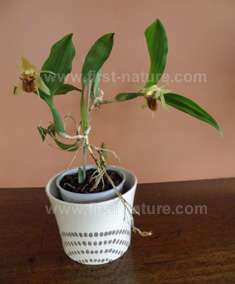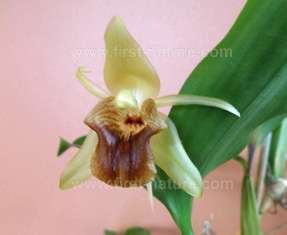Caring for your Coelogyne orchids

Above:- Coelogyne triplicatula surviving very well in a plastic pot
Coelogyne triplicatula
This orchid is far from colourful and for that reason may be less attractive as a houseplant than others in the genus.
Coelogyne triplicatula is native to Burma, and when found growing in the wild, has a creeping habit. Although recommended to be grown in baskets rather than pots, my plant is very happy in its plastic pot, has increased considerably in size and, in it's second year of living with us, produced two excellent flowers.
Along with most of my orchid plants I put this specimen out in the garden in a sunny but sheltered position for a couple of months in the summer. The flowers opened in December after a good spell on a window ledge which benefits from indirect sunlight for most of the year.
It responds well to the watering treatment described below and has so far proved remarkably easy to keep in good condition despite being described as 'difficult' when I acquired the plant.

Above: a close up of Coelogyne triplicatula showing the three 'keels' on the lip from which this species gets its name.
Other kinds of Orchids as House Plants...
Watering your orchid pot plants
By far the best way to water orchids is to place them in a sink or other container of lukewarm water which comes up to the top of their pots. Because they are not growing in densely packed soil or compost, the water will easily rise up from the bottom of the pots and saturate the roots. The plants should be left for several hours, or overnight, and the watering should be repeated on a weekly basis (although most plants will easily survive a 10 day interval if you are away). At the same time as watering, spray the leaves with a fine water mist. Feeding should be kept to a minimum and stepped up only once new growth or flower shoots appear. Never overdo it – food is not high on the agenda of survival for plants that live perched up in trees with their roots exposed!
What about our native wild orchids?
Yes, we have many native wild orchids throughout Europe and around 30 species in the UK. Most of them are rare, endangered or in serious decline due to the destruction of their natural habitats. They will not survive being dug up and moved either to gardens and greenhouses or to window ledges. It is also an offence under the Wildlife and Countryside Act to dig up any wild plants without the landowner’s consent.
Please Help Us: If you have found this information interesting and useful, please consider helping to keep First Nature online by making a small donation towards the web hosting and internet costs.
Any donations over and above the essential running costs will help support the conservation work of Plantlife, the Rivers Trust and charitable botanic gardens - as do author royalties and publisher proceeds from books by Pat and Sue.
Where to see wild orchids
There are many local and national nature reserves where wild orchids can be seen at the right time of year, and the network of local Wildlife Trusts can advise you on the best time to visit and also arrange for you to take part in some of the many tours that they organise during peak flowering times.


